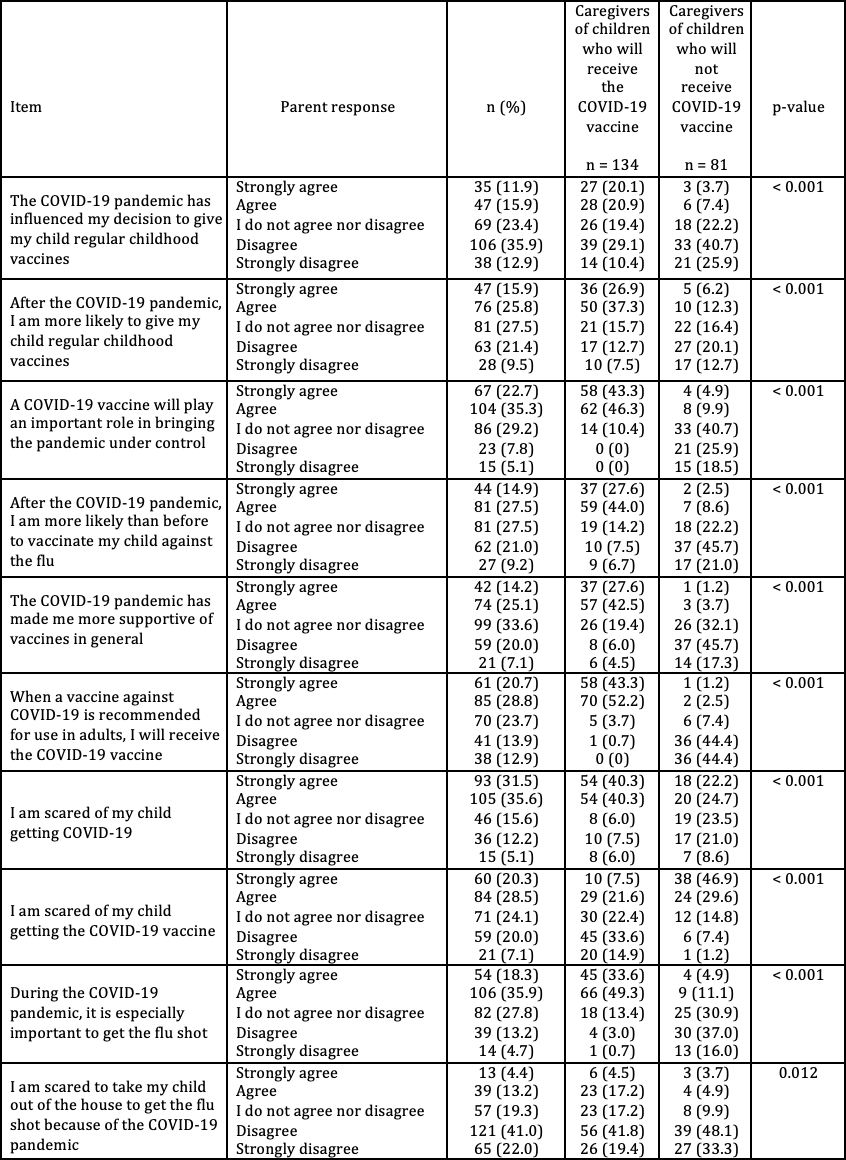Immunizations/Delivery
Category: Abstract Submission
Immunizations/Delivery II
519 - SARS-CoV-2 vaccine hesitancy in caregivers of hospitalized children
Sunday, April 24, 2022
3:30 PM - 6:00 PM US MT
Poster Number: 519
Publication Number: 519.326
Publication Number: 519.326
Marisa Orbea, Texas Children's Hospital, Houston, TX, United States; Rachel Cunningham, Texas Children's Hospital, Houston, TX, United States; C. Mary Healy, Baylor College of Medicine, Houston, TX, United States; Julie A. Boom, Baylor College of Medicine, Houston, TX, United States; Claire E. Bocchini, Baylor College of Medicine and Texas Childrens Hospital, Houston, TX, United States
- MO
Marisa Orbea, MD (she/her/hers)
Fellow
Texas Children's Hospital
Houston, Texas, United States
Presenting Author(s)
Background: Adult SARS-CoV-2 vaccine hesitancy is hindering nationwide vaccination efforts and therefore leaving many parts of the US vulnerable to COVID-19 outbreaks. Little is known about caregiver SARS-CoV-2 vaccine acceptance for children.
Objective: We aim to identify associations with SARS-CoV-2 vaccine hesitancy (VH) in caregivers of hospitalized children.
Design/Methods:
This is a serial, cross-sectional survey in English and Spanish assessing COVID-19 knowledge, attitudes, behaviors, and associated VH among caregivers of hospitalized children 6 months through 18 years. Enrollment took place 12/8/2020-4/5/2021 and 11/30/21-ongoing. VH was assessed using the Parent Attitudes about Childhood Vaccines (PACV) survey; PACV score ≥50 denotes VH. Descriptive statistics and multivariable logistic regression were used.
Results: During ‘20-21, 295/307 (96%) of approached caregivers enrolled; 79% were ≥ 30 years, 68% were married/ living with a partner, and 57% had at least some college. 36% identified as White, 19% Black, and 46% Hispanic/ Latino. 53% of caregiver children had public insurance. 91% of caregivers self-reported their children were up to date with routine vaccines.
Overall, after categorizing results, 67% were scared of their child getting COVID-19. However, 49% were scared of their child getting the vaccine, 28% did not want to vaccinate their child and 27% were neutral in the intention to vaccinate their child (Table 1). Caregivers who intended to vaccinate their child were more likely to be Asian (4.5% vs. 1.2%, p=0.02) and Hispanic/ Latino (33% vs. 49%, p=0.04). VH was identified in 17% of caregivers (Figure 1). 50% of caregivers were willing to receive COVID-19 vaccine themselves and 46% planned to vaccinate their children.Preliminary results for '21-22 show that 105/151 (70%) of parents have received the COVID-19 vaccine, only 13 were vaccinated because it was mandated by their employer. After categorizing results, 70% were scared of their child getting COVID-19, 44% were scared of their child getting the vaccine, and 47% of parents had given or intended to give their child the COVID-19 vaccine.Conclusion(s):
Less than half of caregivers planned to vaccinate their children in ‘20-21 and thus far less than half have vaccinated or intend to vaccinate in '21-22, which leaves many children unprotected and schools without herd immunity. COVID-19 VH is different from VH towards routine vaccines. More research is needed to address COVID-19 specific VH and concerns.
CVMarisa Orbea CV 2021.pdf
Table 1. Caregiver Attitudes, Beliefs, and Behaviors Surrounding the COVID-19 Pandemic and the COVID-19 Vaccine in 2020-2021
Caregiver Attitudes, Beliefs, and Behaviors Surrounding the COVID-19 Pandemic and the COVID-19 Vaccine in 2020-2021
Objective: We aim to identify associations with SARS-CoV-2 vaccine hesitancy (VH) in caregivers of hospitalized children.
Design/Methods:
This is a serial, cross-sectional survey in English and Spanish assessing COVID-19 knowledge, attitudes, behaviors, and associated VH among caregivers of hospitalized children 6 months through 18 years. Enrollment took place 12/8/2020-4/5/2021 and 11/30/21-ongoing. VH was assessed using the Parent Attitudes about Childhood Vaccines (PACV) survey; PACV score ≥50 denotes VH. Descriptive statistics and multivariable logistic regression were used.
Results: During ‘20-21, 295/307 (96%) of approached caregivers enrolled; 79% were ≥ 30 years, 68% were married/ living with a partner, and 57% had at least some college. 36% identified as White, 19% Black, and 46% Hispanic/ Latino. 53% of caregiver children had public insurance. 91% of caregivers self-reported their children were up to date with routine vaccines.
Overall, after categorizing results, 67% were scared of their child getting COVID-19. However, 49% were scared of their child getting the vaccine, 28% did not want to vaccinate their child and 27% were neutral in the intention to vaccinate their child (Table 1). Caregivers who intended to vaccinate their child were more likely to be Asian (4.5% vs. 1.2%, p=0.02) and Hispanic/ Latino (33% vs. 49%, p=0.04). VH was identified in 17% of caregivers (Figure 1). 50% of caregivers were willing to receive COVID-19 vaccine themselves and 46% planned to vaccinate their children.Preliminary results for '21-22 show that 105/151 (70%) of parents have received the COVID-19 vaccine, only 13 were vaccinated because it was mandated by their employer. After categorizing results, 70% were scared of their child getting COVID-19, 44% were scared of their child getting the vaccine, and 47% of parents had given or intended to give their child the COVID-19 vaccine.Conclusion(s):
Less than half of caregivers planned to vaccinate their children in ‘20-21 and thus far less than half have vaccinated or intend to vaccinate in '21-22, which leaves many children unprotected and schools without herd immunity. COVID-19 VH is different from VH towards routine vaccines. More research is needed to address COVID-19 specific VH and concerns.
CVMarisa Orbea CV 2021.pdf
Table 1.
 Caregiver Attitudes, Beliefs, and Behaviors Surrounding the COVID-19 Pandemic and the COVID-19 Vaccine in 2020-2021
Caregiver Attitudes, Beliefs, and Behaviors Surrounding the COVID-19 Pandemic and the COVID-19 Vaccine in 2020-2021